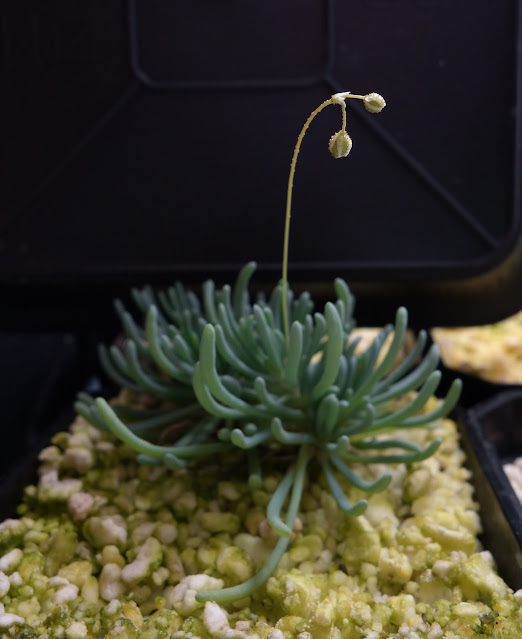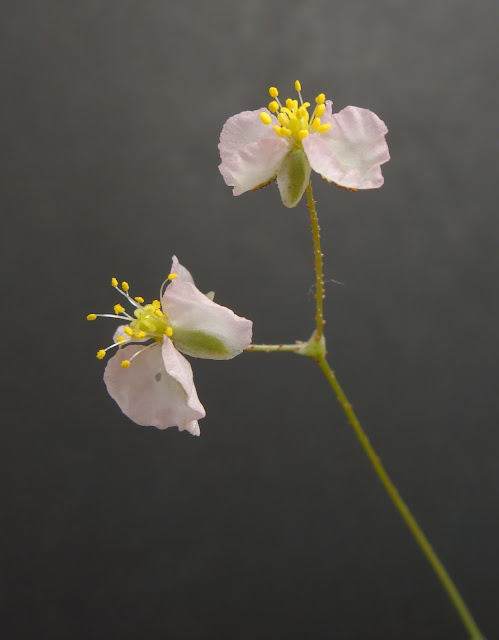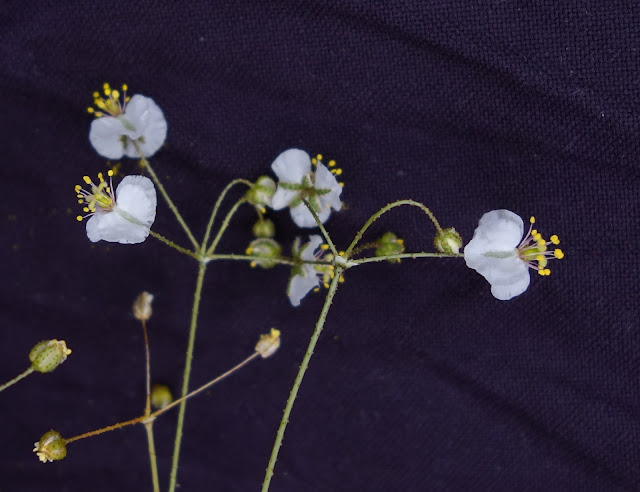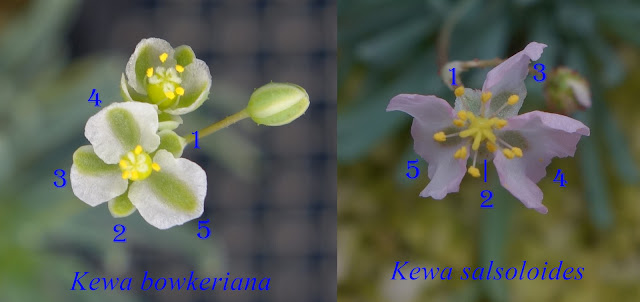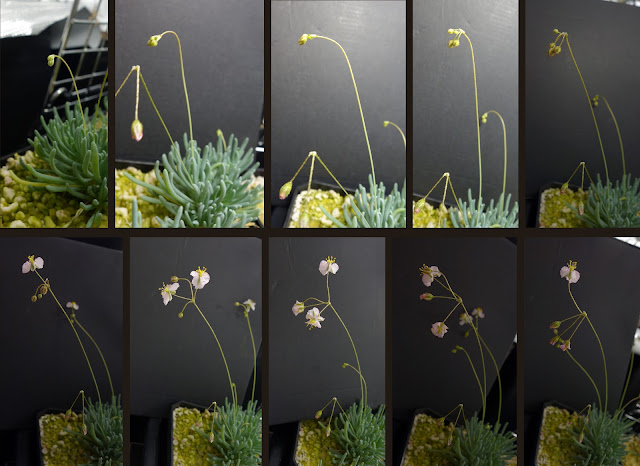My little Kewa salsoloides plants have been flowering continuously for months. Very pretty, pale pink and with a sweet floral fragrance. That is as near as I can pin it down, it evokes memories of other fragrances but I can't say which ones exactly. Perhaps the candied notes of Night Phlox (Zaluzianskaya capensis) flowers but not so much the sugared almonds of which the Night Phlox remind me. More flowers keep developing, providing a constant display.
Chapter Links
Cultivation
Seed
Kewa salsoloides
Kewa salsoloides references
Kewa bowkeriana
Kewa bowkeriana references
Kewa genus
Kewa genus references
Cultivation footnotes
Cultivation
I received the seeds at the end of May and sowed them immediately. I apparently forgot to make a note of the date anywhere and didn't write up labels for them. They came from Lifestyle Seeds in South Africa and had been collected from Ladysmith in KwaZulu Natal. That is on the north and eastern edge of the known area of distribution of the wild plants. The cost of a Phytosanitary Certificate and postage are high but sometimes there is no other way to get some species. While these plants are common in the wild in southern Africa, they appear to have been overlooked by succulent collectors in the UK.
I also seem to have forgotten to take any photos until the 23rd of July. The seedlings were very tiny when they started so I thought there was not much to see. The seeds were really tiny.
I sprouted them on the surface of perlite over pumice in 7cm pots. I crushed a small amount of the perlite to make a top layer that was finer, so the seeds didn't just wash down beyond the light. I sprayed heavily with lightly fertilised water* at 25°C before sprinkling the tiny seeds on the surface very carefully. Then I sprayed again, very lightly so the seeds were not too disturbed.
I put them in completely closed ziplock freezer bags, two or three of the pots in each bag. I put them under strong LED light bulbs (common household Philips - efficient, reliable and cheap)** in a ventilated, heated cabinet so the conditions were stable. They will not have experienced less than 18°C. The bags had two to three centimetres of water in the bottom to keep the perlite damp.
I learnt from the previous batch of seeds of Kewa bowkeriana that I had germinated a few weeks before. Those just dissolved if kept in the closed bags for more than a day or two after sprouting. So, I opened the bags immediately that I saw that some of the seeds had sprouted.
I was terrified of getting it wrong with these tiny seedlings. They come from very dry places but need water to live. Too dry and they die immediately. Too wet and they die immediately. They stayed in the bags for a while with the tops getting more open every few days until they were fully open. I would lightly spray with lightly fertilised water every day. They stayed like that for a while then I started rolling down the sides of the bags so they got a little more air movement (from the gentle fan*** that was not pointed directly at them) and lower humidity. If the water at the bottom of the bag reduced too much, I would very gently water the seedlings with a teaspoon until it was two to three centimetres deep again.
They grew, slowly but surely. The roots came out of the bottom of the pot very quickly. Even the tiny seedlings have very long roots. The plants clearly root deep to ensure they have access to water even in the dry season. The plants could have done with taller pots but I didn't have any tall thin pots to hand. The roots did keep coming out of the bottom of the pots but would be "air-pruned" whenever the the bottom of the tray dried out completely. Unfortunately, Torpedo Pot Rootrainers seem to be rather expensive.
I now have them in a standard seed tray with a centimetre depth of water in the bottom. When that water has completely dried up, I water the pots until it is a centimetre deep again. This takes between three and five days at the moment. They will lose leaves if left dry for too long.
I have read that the plants of this species are very variable. They can be up to 40cm (over 15 inches) in height with leaves up to 4cm (1⁹/16 inches) long.²⁴ My tallest is 6cm (2⅓ inches) with the flower stalks up to 13cm (5 inches) long. I can only presume that I have one of the daintiest types or they grow taller slowly over years. Perhaps, if I let them go dormant, the new growth would get taller before they started flowering profusely again.
I sowed the Kewa bowkeriana seeds on 3/5/23. The first seed sprouted on 7/5/23. Over the next few weeks they germinated erratically. They are now much bigger than the Kewa salsoloides.

Seed
Kewa salsoloides
In Afrikaans, Kewa salsoloides is called braksuring, meaning
"brackish sorrel". This seems to have taken off as "saltsorrel" in
English descriptions of the plants even though brackish means "a bit salty but not as salty as the sea". Another name in the Karoo is haarsuring,⁶ "hair sorrel", presumably from the thin, long cylindrical leaves.
Suring is the equivalent of the English word "souring", a noun meaning "something which makes things sour". It has been used in English for lemon and vinegar but the OED does not mention sorrel. Suring is the usual name for the familiar vegetable sorrel Rumex acetosa in both Dutch and Afrikaans. A South African relative of the common sorrel is Rumex lativalvis, in Afrikaans it is called skaapsuring - sheep sorrel. In England Oxalis acetosella is called wood sorrel. The South African species Oxalis depressa is simply called suring and Oxalis smithiana is called klawersuring - "clover sorrel".⁶ In all these species the sour taste comes from oxalic acid.
The specific name salsoloides comes from the botanical name Salsola. It was thought by the botanist who described² it to be similar to Salsola, a genus of succulent shrubs in the Amaranthaceae family, the most famous of which is Salsola kali. Kew Gardens does not accept the name change of Salsola kali to Kali turgidum. After 12 years I imagine they are not going to. They do accept the name change of Salsola soda (the other famous member of the genus) to Soda inermis. I have eaten Salsola soda/Soda inermis when sold as a vegetable in my local vegan wholefoods supermarket. It is called agretti in Italian. Very tasty, nice texture. The name Salsola appears to have been invented in 1583 as a modern Latin word, meaning "little salty".
As they are not spiny, I imagined Salsola soda/Soda inermis was the species referred to when Kewa salsoloides was named. However, a very young Salsola kali has a vague resemblance in this picture. Perhaps William Burchell, the botanist who gave it the specific name, had seen some more compact, tidy specimens.
The suffix is -oides, meaning "like", "similar to", "having the form of" from the Greek -οειδής -oeides. We use the same ending in English for the ending of words like ovoid (like an egg), asteroid (like a star), steroid (like a sterol, a class of compounds found in plants and animals), solenoid (like a channel, pipe, syringe or shellfish), thyroid (like an oblong shield), opioid (like an opiate narcotic), sleazoid (like Russell Brand), humanoid (like a human), hominoid (like a human), anthropoid (like a human), android (like a man) and the underused gynoid (like a woman, like most science fictional anthropoid robots).
The first name and description given to the species by a botanist was as Pharnaceum salsoloides in 1822. This was just a description consisting of seventeen words in a footnote in Latin.² "Looks very unique" being three of those words (Species valde singularis). On the same page, Burchell remarks on the use of Afrikaans place names in the locations mentioned: "It is certainly bad taste to substitute, in any country, a modern or a foreign name, for one by which a place has been for ages known to its native inhabitants." Rather respectful for an English explorer in 1822.
Type specimen of Pharnaceum salsoloides collected by WJ Burchell in 1822. Apparently misfiled by Kew Gardens in their Data Portal as Suessenguthiella in the Molluginaceae. I emailed them about it but have not heard back yet. Kew Specimen: K000232012Kewa salsoloides is native to Botswana, Namibia and South Africa. For 234 pictures of the plant, see the entry on GBIF. On GBIF there are several herbarium specimens that are the types for various names that have now been included in Kewa salsoloides
but the original specimen collected by Burchell is only at Kew.
Hypertelis salsoloides was first published¹ as a name in 1957. For more previous names from botanists, see its entry on POWO.
The former species Pharnaceum verrucosum was described⁴ in 1836 and published⁵ as Hypertelis verrucosa in 1840. It is now regarded as part of the species Kewa salsoloides. The specific name verrucosum means "warty", from the Latin verrucosus. This referred to the lumpy purple glands you can see in some of the photos above.
The genus Pharnaceum was created by Linnaeus in 1753 and there are some species still regarded as members of that genus, still placed in the same family as Hypertelis - Molluginaceae. The name appears to come from a Greek name (Pharnakeion - Φαρνάκειον) for a type of centaury, a cure-all medicinal plant used by centaurs. Linnaeus (and many other early botanists) often took random Greek plant names and used them for unrelated plants they had been sent from half a world away from Greece.
I am unsure where the name Hypertelis came from. There is a Greek word hyperteles ὑπερτελής meaning "overleaping" "of a beacon: leaping over the strait" "rising or appearing above" "of numbers the sum of whose factors (including unity) is greater than themselves" "of payments: due". I can't see the relevance of any of those from the description⁴ of the new genus and the two species Hypertelis verrucosa and Hypertelis spergulacea. Unless it describes the flowers held on a long stalk.
Nora Zabinkova gave "overleaping" as the origin of Hypertelis in her list of generic names ending in "is". Her comparison with Herpestis (and therefore Cercestis, Euchaetis and Lamprotis) suggested that the ending changed from -es to -is as an alteration to the feminine.⁷
Casabio uses etymologies from The Illustrated Dictionary of Southern African Plant Names by Hugh Clarke, Michael Charters and Eugene Moll (2016, Jacana Media). They claim the etymology is "Gk. hyper- = above; telos = end, consummation; referring to the fleshy leaves." The etymology they give for Caralluma is the nonsense about Arabic flesh wounds which I debunked in another article. I do not regard that book as a reliable source and the etymology they offer does not seem to make sense. It is the etymology of a concept in biology proposed in 1873 and in the Oxford English Dictionary as hypertely, originally German hypertelie.
Hypertely is the extreme development of a characteristic to the point where it is beyond being useful for the animal. It is derived from an actual ancient Greek compound word hyperteleios ὑπερτέλειος meaning "beyond completeness or perfection". Perhaps Ernst Meyer thought it was a perfect little plant. The Greek word telos τέλος means a lot of different things.
The Red List for South African Plants from 2015 gives the English common name of Kewa bowkeriana as Wild Fenugreek. The ancient Greek word telis τῆλις means fenugreek. "Hyper" could be translated as "wild" in modern slang, but is usually "over", "beyond" or "above". I can't find any earlier evidence for this name. The seeds could be said to be like fenugreek with a bit of imagination but in the original descriptions of the new genus Hypertelis the seeds were described as like little lentils (lenticularia) or pear-shaped (pyriformia).
There are now 104 species (accepted by Kew) of the genus Trigonella, which contains the fenugreek of commerce Trigonella foenum-graecum.
I found a list of plants collected by Jean François Drège, sorted by location of collection.³ Trigonella hamosa, Hypertelis spergulacea and Hypertelis verrucosa were all collected in the same area by Drège, the location designated III, B, 8. The location was described as:
"Garip, near Verleptpram, on the banks of the river and in the stony lowland, below 500 feet, September."
In the original German:
"Garip, bei Verleptpram, am Ufer des Flusses und in der steinigen Niederung, unter 500 Fuss, September."
A specimen stored at the Herbarium of the the Swedish Museum of Natural History has five collections by Drège of Hypertelis salsoloides/verrucosa on one sheet. There it shows that the variety collected in location "III, B, 8" is Lusus I, the first in the list of varieties in the description by E. Meyer of Hypertelis verrucosa. The Herbarium of the Muséum National de Histoire Naturelle in Paris has separate sheets for all three collections by Drège. Lusus 1 Lusus 2 Lusus 3
I found one of the specimens of Trigonella hamosa collected by Drège in the Herbarium of the Hamburg Botanical Gardens, but there was no more information on it. Except that the collections were in 1830, which I couldn't confirm elsewhere.
Three specimens of Hypertelis spergulacea collected by Drège are in the Herbarium of Martin Luther Universität Halle Wittenberg. No additional information on the herbarium specimens: 1 2 3
Could the genus Hypertelis really have been named because the two species were found upslope from a species of fenugreek? Simply "above fenugreek"? I don't know of any plants that have been named for a similar reason but there are some wacky botanical name origins.
Kewa salsoloides references
² Burchell, William J Travels in the Interior of Southern Africa (1822, London) 1: 286
https://www.biodiversitylibrary.org/item/181911#page/320/mode/1up
³ Drège, Jean François "Zwei pflanzengeographische documente" Special addition to Flora. (1843) 61, 67, 92
III b 8 https://www.biodiversitylibrary.org/page/45743120#page/98/mode/1up
II f 7 https://www.biodiversitylibrary.org/page/45743120#page/73/mode/1up
II c 2 https://www.biodiversitylibrary.org/page/45743120#page/67/mode/1up
https://www.biodiversitylibrary.org/page/41200404#page/275/mode/1up
http://opus.sanbi.org/bitstream/20.500.12143/280/1/Common%20names%20of%20Karoo%20plants%20for%20public%20view%20on%20website.pdf
https://www.iapt-taxon.org/historic/Congress/IBC_1969/in_is.pdf
Kewa bowkeriana
Named after Miss Mary Elizabeth Bowker (1818 - 1899), who had collected the specimen that became the type of the species.¹⁷ By the time it was named, she had become Mrs Mary Elizabeth Barber. Kew Gardens has the type specimen. Though currently their Data Portal is in testing, so the address may change at some time in the future.
Biographical Notes for Mary Elizabeth Barber née Bowker.
I
have tried to put together a brief outline of the life of Mary but it
is impossible to do justice to her complex and long scientific career in
such a short form. For a more complete analysis of Mary's life, unhappy
marriage, scientific observations, contributions and collaborations,
feminism and philosophy, please see the 360 page Open Access biography by Tanja Hammel.¹⁶ For a shorter biography that concentrates on her academic life and lists her writings and art, see that by Alan Cohen.¹⁵
Mary was born
in South Newton, a village near Salisbury, Wiltshire, England, on the 5th of January 1818. Her family brought her to South Africa when she was a
toddler. They were taking advantage of the Cape Colony government's
offer of 100 acres of South African land to every male over the age of
18 who arrived to settle there. She later became Mary Elizabeth Barber
when she married. She appears to have had markedly and outspoken
feminist views far ahead of her time. Unfortunately, it seems that she
assumed the racial superiority of white
people, as many of the British settlers in South Africa did in the
late 19th century.¹⁵
She worked closely (from a great distance)
with William Harvey of Trinity Herbarium, Dublin and Joseph Dalton
Hooker, the director of Kew Gardens and corresponded with many other scientists. These
included Edgar Layard, the first curator of the South African Museum in
Cape Town. An avid collector of new plant
species from 1840 to 1879, sometimes with her professional soldier
brother James. In 1845, she married Frederick William Barber and so is
sometimes referred to as Mrs FW Barber. Her scientific papers were
usually credited as Mrs ME Barber.
Mary began painting a series of scientific illustrations of South African birds in 1862. Between 1863 and 1882 she sent over a hundred letters about insects to Roland Trimen, who went on to co-author the three volumes of South-African Butterflies; A Monograph of the Extra-tropical Species with her brother James from 1887 to 1889.¹⁸ There were numerous mentions crediting her observations throughout the text. In the Preface, Trimen mentioned his indebtedness to her help:
To Mrs. F. W. Barber, the sister of Colonel Bowker, I am also greatly indebted. Long known to European botanists for her attainments and discoveries in regard to the Flora of the Cape, this lady had a wide acquaintance with South-African Natural History generally, and in 1863 turned her attention specially to the Lepidoptera. With characteristic generosity — knowing that I was engaged in bringing out a book on the subject — Mrs. Barber offered me the fullest aid, and constantly since then have her net, pen, and artistic pencil been actively engaged in furtherance of my work. Of special value have proved her graphic accounts of the habits and stations of the butterflies of the Eastern Districts of the Cape Colony, where she has chiefly resided, and her excellent coloured drawings of larvæ and pupæ, some of which are reproduced in Plates I. and II. of this volume. My friend's strong love of nature and keen observant powers are happily shared by her daughter, Mrs. Bailie, and her two sons, Mr. Frederick and Mr. Henry Barber ; and many of the most interesting captures and discoveries recorded by Mrs. Barber are due to their enthusiastic co-operation as collectors and observers. Mr. F. and Mr. H. Barber have also independently rendered me much service by sending down several collections made in the Transvaal and the country northward to the Zambesi.¹⁸
Plants were named after both her maiden and married names.¹⁵ She was not paid by Harvey or Hooker but received journals in exchange. Mary told Harvey that she would always be in his debt for his book The Genera of South African Plants of 1838, which had changed her life by starting her avid interest in botany and plant-collecting.¹⁵
Two papers that she submitted to The Linnean Society of
London⁹ ¹¹ and one submitted to the Royal Horticultural Society¹⁰ were read to those societies by Joseph Dalton Hooker. Mary was a supporter of and corresponded with Charles Darwin. Darwin read
a short communication of hers on colour changes in butterfly larvae and
pupae to the Entomological Society of London on the 2nd of November
1874, illustrated by her own drawings.¹²
Mary also provided botanical illustrations to Kew Gardens. Her other researches extended beyond insects, birds and plants, including geology, fossils and Stone Age remains. At the age of 71 she received some money that was enough to allow her to visit Europe and she saw Kew Gardens and some of her scientific collaborators for the first time.¹⁵
Throughout her career, Mary often made observations of gender roles in animals that were contrary to the assumptions made by most male scientists of the time. For example, she described many birds which co-parented their offspring, rather than the usual assumption that the mother bird did all the chick-rearing.
"Barber lamented her husband’s lack of participation in raising their children, which would have allowed her more time for her own scientific pursuits.... ...the stubbornness and arrogance of men, which led them to act irrationally and thoughtlessly by confining women to a world of household chores and parenting."¹⁶She wrote several papers of her own. She became a member of the South African Philosophical Society in 1878, a year after its founding. She had a paper published in the journal in that year¹³ that had, presumably, won her membership and another in 1880.¹⁴ She died at the age of 81 in Pietermaritzburg, now in KwaZulu-Natal, South Africa on the 4th of September 1899.¹⁵
Kewa bowkeriana references
⁸ Barber, ME & Hooker, JD "Brachystelma barberiae, Mrs Barber's Brachystelma" Curtis's Botanical Magazine (1866) Series 3, Vol. 22: Tab: 5607 Lithography by Walter Hood Fitch.
https://www.biodiversitylibrary.org/item/14368#page/286/mode/1up
⁹ Barber, ME "On the Structure and Fertilisation of Liparis Bowkeri." The Journal of the Linnean Society: Botany (1869) 10: 455-458
https://www.biodiversitylibrary.org/item/8361#page/462/mode/1up
¹² Barber, ME "Notes on the peculiar habits and changes which take place in the larva and pupa of Papilio Nireus." The Transactions of the Entomological Society of London (1874) Part 4: 591-521 & Plate IX
https://www.biodiversitylibrary.org/page/14921833#page/541/mode/1up
https://www.biodiversitylibrary.org/page/14921833#page/657/mode/1up
https://www.researchgate.net/publication/250230103_Mary_Elizabeth_Barber_South_Africa's_first_lady_natural_historian
https://link.springer.com/book/10.1007/978-3-030-22639-8
https://www.biodiversitylibrary.org/item/15231#page/201/mode/1up
https://www.biodiversitylibrary.org/item/186212#page/19/mode/1up
The genus Kewa and the family Kewaceae were
invented¹⁹ in 2014 for a small group of plants that were already well-known to
botanists. As was usual, they had been classified on the basis of what they looked like. The genus to which they had previously been assigned was Hypertelis
in the Molluginaceae. When eight of these species were genetically tested they were found to be unrelated to the
type species of the genus - Hypertelis spergulacea. So eight of those species had to be renamed and placed in a new genus and family.
The genus Kewa and the family Kewaceae were then invented to take the species that were moved out of Hypertelis. The new name was given to honour the small village of Kew near Richmond, Surrey in the south of England. Coincidentally, this is the location of some Royal Botanic Gardens.¹⁹
For a while Hypertelis spergulacea was the only species left in that genus. Since then, six more species have been placed in the genus Hypertelis that had turned out to be related to the type species. Four in 2016,²³ two in 2018.²² All the new species of Hypertelis had all previously been placed in Mollugo or Pharnaceum, still in the Molluginaceae.
Kewa and Hypertelis are still all in the same Order but the Order Caryophyllales is a huge and varied group of families. It includes ice plants and Lithops (Aizoaceae), beet, spinach, samphire and fat hen (Amaranthaceae), cacti (Cactaceae), carnations, chickweed and campions (Caryophyllaceae), elephant bush, octopus tree and Madagascar ocotillo (Didieriaceae), sundews (Droseraceae), tropical pitcher plants (Nepenthaceae), Bougainvillea and Marvel of Peru (Nyctaginaceae), knotweed and buckwheat (Polygonaceae) and purslane (Portulacaceae) - among many other less famous plant families.
The Kewaceae are not regarded as being close to their previous family Molluginaceae. The huge family Aizoaceae, the large family Nyctaginaceae and six small families are related more closely to Kewa than Hypertelis and Kewa are to each other. The huge cactus family Cactaceae and seven small families are related more closely to Hypertelis than Hypertelis and Kewa are to each other.²⁵
The flowers of Kewa species are composed of five tepals, a name used for flower organs that are not distinguishable as petals or sepals. Two are like sepals (1&2), one is half-way between (3) and
two are like petals (4&5). I don't think I have ever heard of a plant with 2½ petals before.
The genus Kewa are all small and relatively succulent-leaved shrubs.
Both the species that I am growing have been used for food but they contain a lot of oxalic acid. Too much oxalic acid can lock up minerals in food eaten with it and can cause kidney damage by precipitating needle-like crystals of calcium oxalate from the blood, resulting in death in some cases. I tasted one tiny leaf of Kewa bowkeriana that I accidentally broke off a plant when moving it. It was definitely acidic to the taste but not as much as Oxalis leaves or French sorrel. A pleasant mild tartness, not enough to pucker the mouth. Though it was only a tiny leaf.
The only one of the eight species of the genus Kewa that is listed on the Red List of Threatened Species is Kewa acida. Kewa acida is restricted to a few locations on the south coast of the tiny south Atlantic island of St Helena.²⁰ Kewa acida has been assessed as Critically Endangered.²¹
For all the details on the species of the genus Kewa, please see the three articles linked in the Bibliography below.¹⁹ ²⁰ ²⁴
Kewa genus references
¹⁹ Christenhusz, Maarten J.M.; Brockington, Samuel F.; Christin, Pascal-Antoine and Sage, Rowan F. "On the disintegration of Molluginaceae: a new genus and family (Kewa, Kewaceae) segregated from Hypertelis, and placement of Macarthuria in Macarthuriaceae" Phytotaxa (2014) 181(4): 238–242 Link to paper on Researchgate.
²² Sukhorukov, Alexander P et al "Chorological and taxonomic notes on African plants" Botany Letters (2018) 165(2): 228-240
https://www.tandfonline.com/doi/full/10.1080/23818107.2018.1465467
²³ Thulin, Mats et al "Phylogeny and generic delimitation in Molluginaceae, new pigment data in Caryophyllales, and the new family Corbichoniaceae" Taxon (2016) 65(4): 775–793
http://edwardslab.org/reprints/thulin_etal_taxon2016.pdf
²⁵ Tree of Life Explorer, Kew Royal Botanic Gardens. Basis described in Baker, WJ et al "A Comprehensive Phylogenomic Platform for Exploring the Angiosperm Tree of Life." Systematic Biology (2022) 71: 301–319
https://doi.org/10.1093/sysbio/syab035
https://treeoflife.kew.org/tree-of-life
Cultivation footnotes
* My fertiliser recipe for small, slow-growing succulents is a bit complicated and over fussy but you could probably get away with using just Vitalink Plant Start with malic acid to adjust the pH to get around 6, which is ideal for most (not all) plants. The amount needed to adjust the pH will depend on the alkalinity of your local tap water which varies a lot even across the UK.
15 litres tap water
10ml Vitalink PlantStart (available from most hydroponics shops)
15g MgSO4 (magnesium sulphate or Epsom salts)
4g CaSO4 (food grade calcium sulphate or gypsum) This won't all dissolve but don't worry about that.
0.2g K2SO4 (fertiliser grade potassium sulphate)
0.25g malic acid, the characteristic organic acid of apples and raspberries.
With Manchester water this is enough to get a very, very pale green with a 6-7.6 pH indicator liquid. This should be approximately pH 6. Other acids such as citric acid and vinegar can be used. Hydroponic stores sell phosphoric acid (pH Down) for this purpose but it is more difficult to handle as it is liquid and a much stronger acid, therefore more dangerous. Syringes don't last as long if you use them for phosphoric acid.
Always leave the water in a large lidded bucket to reach room temperature or add enough warm water to get to 20 to 25°C. You don't want to shock the roots with chilly water, especially with fussy subtropical or tropical plants.
Add all the solid ingredients and stir thoroughly for half a minute or so. Add the PlantStart and stir again. Using a 10ml syringe
is a good way to measure the liquid. You can help mix and oxygenate the
water by squirting the mix back in forcefully after stirring, the thin
jet of water drags lots of little bubbles under with it. This also helps
rinse the syringe.
I do believe that most commercial liquid fertiliser manufacturers
compromise on the quantity of magnesium and calcium salts they add.
These can cause problems with solubility, causing solid crystals to drop
out of the concentrated solution. I used to have problems with
yellowing leaves in some plants before I started adding Epsom salts and
gypsum.


